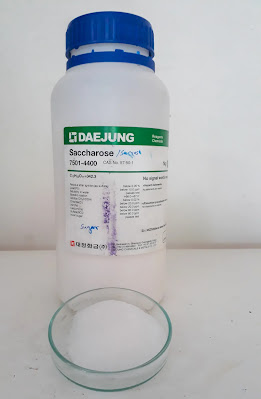CHEMICAL PRODUCT IDENTIFICATION
- Read –Saccharose SDS!
- Product Namely: Sucrose.
- Signal Word: N/A.
HAZARDS IDENTIFICATION
- According to the GHS classification for the Hazard Communication Standard, this chemical is not deemed dangerous.
- All laboratory substances should be handled with care.
- Despite the fact that this substance is regarded as nonhazardous, unexpected chemical reactions are always conceivable.
- Responsible laboratory procedures should be followed.
- Given that it was stored with other chemicals that are not food-grade, the product should be handled as a chemical & should not be consumed.
COMPOSITION, INFORMATION ON INGREDIENTS
- Name of Component: Sucrose.
- CAS Number: 57-50-1.
- Formula: C12H22O11.
- Formula Wt.: 342.31
FIRST-AID MEASURES
- If you feel unwell, contact a doctor.
- If inhaled: Remove the victim to fresh air & keep them at rest in a breathing-friendly position.
- If in the eyes: Carefully rinse for a few minutes with water. If contact lenses are present and simple to remove, do so. Rinsing continues.
- If on the skin: Thoroughly rinse with water.
- If Swallowed: Rinse mouth if swallowed. If you feel unwell, contact a doctor.
FIRE-FIGHTING MEASURES
- It is non-flammable (solid).
- Toxic gases could be released during decomposition when heated.
- Use a tri-class dry chemical fire extinguisher in the event of a fire.
ACCIDENTAL RELEASE MEASURES
- Clean up, put in a sealed bag or container, & throw away.
- After item pickup is complete, clean the spill scene.
HANDLING & STORAGE
- When not in use, keep containers closed.
- Store far from heat sources, sparks, & open flames in a cool, dry place within a chemical safety bag has been preferred along with good ventilation.
- Avoid moisture to prevent the growth of mould or clumping.
- Utilize sufficient ventilation.
- Avoid making extended skin contacts.
- Store alongside amides, amines, glycols, & alcohols.
EXPOSURE CONTROLS, PERSONAL PROTECTION
- Avoid making eye contact.
- After handling, carefully wash your hands.
- recommendations for exposure (as a cloud of total dust) OSHA PEL 15 mg/m3; TLV 10 mg/m3 (ACGIH).
PHYSICAL & CHEMICAL PROPERTIES
- Appearance: Such crystals that are hard, white, or colored spheres or cylinders.
- Odor: Appears as a Malt-like odor.
- Solubility: It is soluble in water & slightly soluble in alcohol.
- Boiling point: not applicable.
- Melting point: 186 °C.
- Flash point: not applicable.
- Vapor pressure: not applicable.
- Vapor density: not applicable.
- Specific gravity: 1.569 g/cm3 at 20 °C.
- Solubility in water: Soluble.
- Not ingestable to humans.
STABILITY & REACTIVITY
- Keep the material away from strong oxidizers.
- It is considered an indefinite shelf life if properly stored & kept dry.
TOXICOLOGICAL INFORMATION
- Acute effects: N/A.
- Chronic effects: N/A.
- Target organs: N/A.
- LD50 for ORL-RAT: 29,700 mg/kg
- LC50 for IHL-RAT: N.A.
- LD50 for SKN-RBT: N.A.
ECOLOGICAL INFORMATION
- Wastewater, pollutants, & solid waste from sugar mills have an effect on the environment. Large fish deaths result from the massive amounts of plant matter & sludge that are washed from mills into freshwater bodies, where they decompose & consume all the oxygen.
DISPOSAL CONSIDERATIONS
- Dispose of in accordance with local, state, & federal rules or laws.
TRANSPORT INFORMATION
- Name of shipment: Unrestricted. Risk category: N.A. UN identifier: N.A.
REGULATORY INFORMATION
- TSCA & EINECS listings (200-334-9).
OTHER INFORMATION
This Saccharose SDS is intended as a guide & is based on data & tests that are likely to be reliable. I don’t guarantee the data’s correctness or completeness & I’m not responsible for any resulting losses. The information is only being provided for your review, research, & verification. I DO NOT ASSUME RESPONSIBILITY AND EXPRESSLY DISCLAIM LIABILITY FOR LOSS, DAMAGE, OR EXPENSE RESULTING FROM OR IN ANY WAY CONNECTED WITH THE HANDLING, STORAGE, USE, OR DISPOSAL OF THIS PRODUCT FOR THE FOREGOING AND OTHER REASONS.

A white, crystalline powder with a sweet flavour is saccharose, sometimes referred to as table sugar or sucrose. It is frequently used to sweeten food & drinks, as well as in the manufacture of cosmetics, medications, & industrial chemicals.
CONCLUSION
A common sweetener, saccharose, is non-toxic when consumed in tiny amounts. However, excessive consumption is a risk factor for diabetes, obesity, & other health issues. Saccharose must be handled & stored properly to avoid the growth of mould or clumps & to preserve the product’s quality. It is not regarded as a dangerous material, thus wiping up spills with a damp cloth or sweeping is sufficient. Always follow Saccharose SDS.
